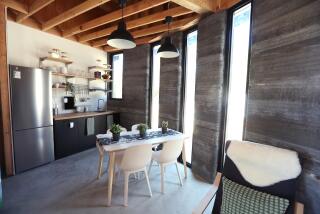The Ultimate in Do-It-Yourself : Amateurs Inspired by Institute to Build Home
- Share via
BATH, Me. — Joyce Cowfer was in tears when she called Pat Hennin with the news that she had miscalculated the size of her foundation and realized that it would cost nearly $1,000 more to build her Maryland home.
Not to worry, said Hennin, co-owner of the Shelter Institute and Cowfer’s former instructor. He consoled her, patiently explained how to correct her blunder, and even drew diagrams and mailed them to her.
Within a few months she was done: three bedrooms, two baths, passive solar heat and a Jacuzzi, and all for $55,000--about one-third market value.
“They not only give you the information, they give you the confidence,” Cowfer said. “You don’t need building experience.”
For 15 years, Hennin, his wife, Patsy, and several other instructors have taught students how to tackle the forbidding task of building a home--at less than half the cost of buying the finished home or hiring someone to build it.
People who build their own homes are more satisfied, Hennin said. Less hurried than a contractor, the do-it-yourselfer will examine every aspect of the building process and make carefully considered decisions.
“Contractors don’t shop around” and generally do not match solutions to specific problems, he said. The contractor “simply does it this way” because that’s the way it was always done.
More than 14,000 students from around the world, including novices who barely knew which end of the hammer to hold, have attended the school located in a 120-year-old brick building in this coastal town north of Portland. The students range in age from 18 to 70 and have included lumberjacks, doctors, Madison Avenue executives, carpenters, engineers and architects.
Students can choose the 15-week, one-day-a-week session for $450 per person or $725 per couple, or opt for compressed sessions of two or three weeks for slightly more money. Classes are limited to 40 students.
All students learn how to survey a lot, pour a foundation, design and build every inch of a house. They also receive instruction in the concept of heat, the physics of materials, engineering, framing and financing.
The information “was presented in such a way that it was non-intimidating,” said Gary Miers, 34, who is spending $50,000 to build a house valued at $140,000 in Raymond. “It was presented in a relaxed fashion.”
Mistakes aren’t ruinous, Hennin said, because “there isn’t anything in a house that isn’t forgiving.”
That is comforting news for students who also quickly learn that the mistakes they make are much less costly than if a contractor were building the house.
“When a contractor walks into a store, he doesn’t ask what the price is. He just assumes he’s getting the wholesale cost,” but the price may be lower elsewhere, Hennin said.
For example, a shelter institute student can make insulated glass windows for about $3 per square foot, whereas a contractor is likely to pay $10, Hennin said. All the lumber needed to build a house rarely would exceed $4,000, he added.
The Hennins, both 45, began their business in 1974. Hennin, who had just finished law school and had some prior building experience, was hired to help build a house for a friend. Soon he had other offers to build, and his wife’s interest in home construction surfaced.
“We had a choice of building houses for the rest of our lives or getting involved in another way--teaching people,” Patsy Hennin said.
Housing styles have changed over the last 15 years. After the simple, box-style homes that marked the days of energy conservation and the back-to-the-earth movement of the early and mid-1970s, underground homes became popular. Those now have been replaced by elaborate designs more reflective of the 1980s: prosperity, sophistication and self-indulgence, Patsy Hennin said.
Jim and Roxie Westbrook of Santa Cruz, Calif., are building a passive-solar country house on the outskirts of the nearby Henry Cowell Redwoods State Park, complete with a hot tub and more gadgets and fixtures than they had in the older homes they owned.
“There’s nothing cheap in it,” Roxie Westbrook said in a telephone interview. “When it’s a choice between quality and going for quality, we go for quality.”
Others prefer a home that is unadorned. Miers and his wife left Pennsylvania with the romantic notion of building a home that embraced their 1960s values--the desire to be independent, energy-efficient and frugal.
But despite changing tastes, Patsy Hennin says most people are joined by a creative urge and a determination to take control of their lives.
“It’s a grabbing of life, rather than letting life roll you over,” she said. “If houses cost so much, it’s your responsibility to figure out a way for them not to cost so much.”
More to Read
Sign up for Essential California
The most important California stories and recommendations in your inbox every morning.
You may occasionally receive promotional content from the Los Angeles Times.










